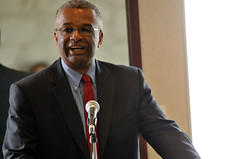An unprecedented partnership between federal agencies was on full display at a press conference this morning on the 23rd floor of the Portland Hilton. The occasion was the announcement of a $2 million federal grant for Washington County through the Obama Administration’s TIGER II program. The grant will go toward a transportation and community planning project for the Aloha-Reedville community (between Hillsboro and Beaverton).
I’ll share more about that project later today, but I want to share a conversation I had prior to the formal portion of the event with the Deputy Secretary of the Department of Housing and Urban Development (HUD), Ron Sims.
“We now know it’s very very costly to support expansion and distance and the smart thing to do is to have people in more intimate, functioning neighborhoods.”
During the brief interview, Sims shared more about how this Washington County grant is a direct outcome of President Obama’s interest in tying our investments in transportation with public health and livable community outcomes (and of course, I also asked him about bicycling’s role in that equation).
Sims is the former King County Executive (based in Seattle). He recalled that when President Obama campaigned through Portland and Seattle in 2008, he was struck by, “How everything seems to be woven together” in terms of transportation and housing (the 70,000 people that showed up to Waterfront Park for his rally — many of them via bus, MAX and bicycle — probably left an impression). After he was elected, during an interview for the HUD job, Obama asked Sims, “How did you do that?”
“You can’t tell a person who is obese that you need exercise if the sidewalks are narrow and there are no walking or bicycle paths.”
When Obama asked Sims what his biggest barrier was to integrating transportation and housing, he said without hesitation, “The federal government.” Sims got the job.
Sims was referring to silos that existed between the DOT, HUD, and the Environmental Protection Agency. With colleagues at those agencies on board and “What started as a really good question from the President,” Sims says the silos no longer exist and the collaboration has “blossomed.” (Specifically, the heads of the DOT, HUD, and the EPA now work together in the Partnership for Sustainable Communities.)
In my brief discussion with Sims, I came away feeling like he really gets it. Below are some excerpts…
On planning and density:
“We always thought you had to integrate the built environment with transportation, the issue is to do it in a sustainable fashion. The cities of the future are the cities that will be smart resource-wise. We’re going to have density, the issue is, how do you move around that density? Do you provide arterials that you’ll have to rebuild and rebuild and rebuild; or do you provide options for people such as public transportation, pedestrian pathways, and bicycle paths?
… We now know it’s very, very costly to support expansion and distance and the smart thing to do is to have people in more intimate, functioning neighborhoods.”
On equity, transportation, and bicycling:
“Another thing we brought into play were equity issues. We can predict lifetime earnings of kids and the health outcomes of our populations by by zip code. We were looking at these disparities and said, ‘How do you break the disparities?’
As this country begins to rebuild its neighborhoods and build new ones, we have to ask, ‘What does a healthy neighborhood look like?’ You can’t tell a person who is obese that you need exercise if the sidewalks are narrow and there are no walking or bicycle paths. So we said, why not start to incentive and encourage people to plan those type of neighborhoods?
In King County for instance, we have a pretty extensive bike network, but none of them in poor neighborhoods. I used to ride with a friend and I’d say, ‘You and I bike a lot, but no one looks like us.’ The reason why is because we do not have bike paths in poor neighborhood. We want people to bike and bike safely. Biking in the street is not safe and biking on sidewalks is a hassle. We have to create what I call ‘bicycling opportunities.’
I bike to work and I’m a believer in bicycling both for health and transport. For us, we believe it is a choice people should be able to make and it should be convenient for them to make it. You can also created dedicated bicycles paths for people who don’t want to be ‘street savvy’. It’s hard enough bicycling without having to worry about the driver on the cell phone who doesn’t see you.”
On bicycling and health:
“We’re seeing early onset of Type II diabetes among kids. Our issue about getting people on bicycles is very important because if the Type II diabetes bulge continues it’s going to collapse our health care system. So the reason we have a strategic interest in bicycling and we’re looking at bicycling as a strategy is to say, we’ve gotta get these kids on bikes to school, to the playground, to the store, to see their friends…
We know that with the bicycle as a method of transportation and exercise we can lower obesity rates in this country. And remember that obesity is occurring in poor neighborhoods, not in affluent neighborhoods… Those kids in affluent neighborhoods tend to have bicycle paths, so one of our social goals is to say, ‘Make those investments dog gone it!'”
It’s one thing to hear about all these issues from non-profit groups and research papers, but to hear this perspective and understanding directly from the horse’s mouth, is very re-assuring.


